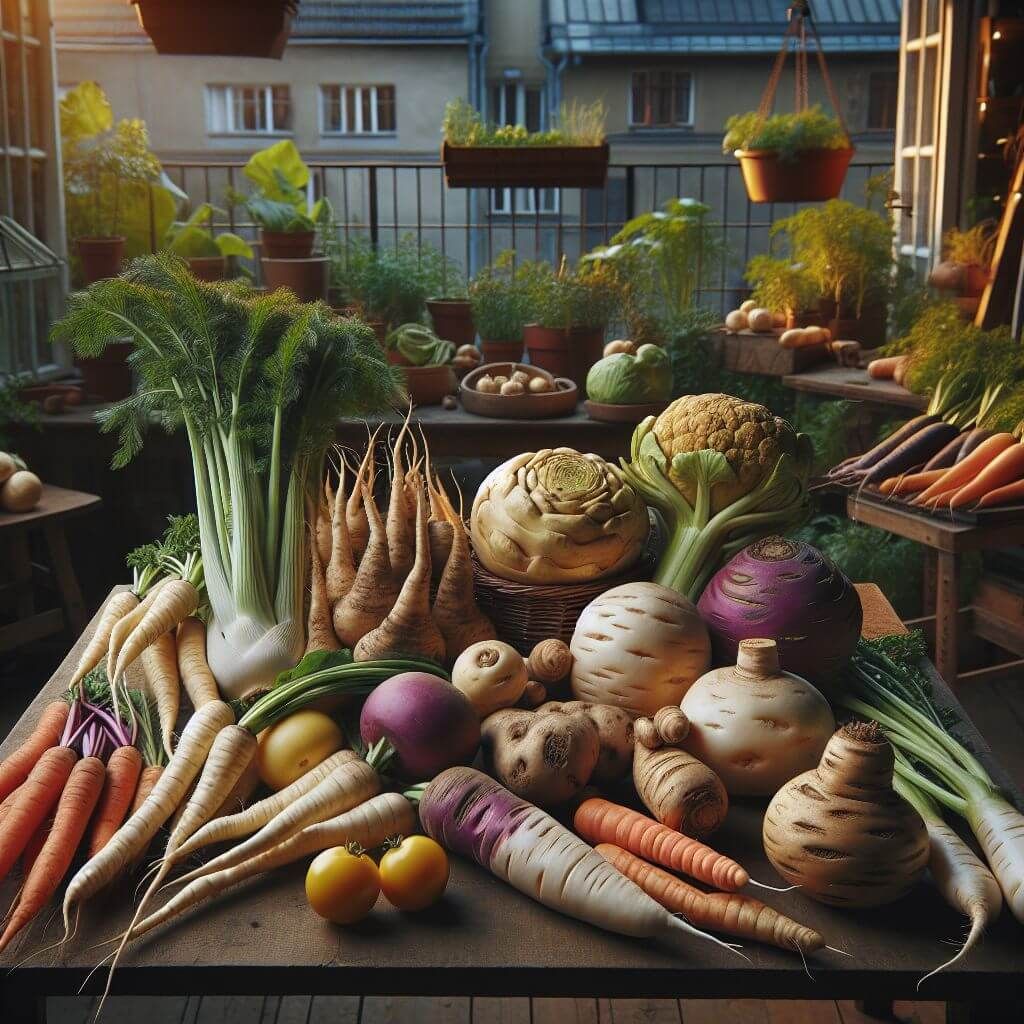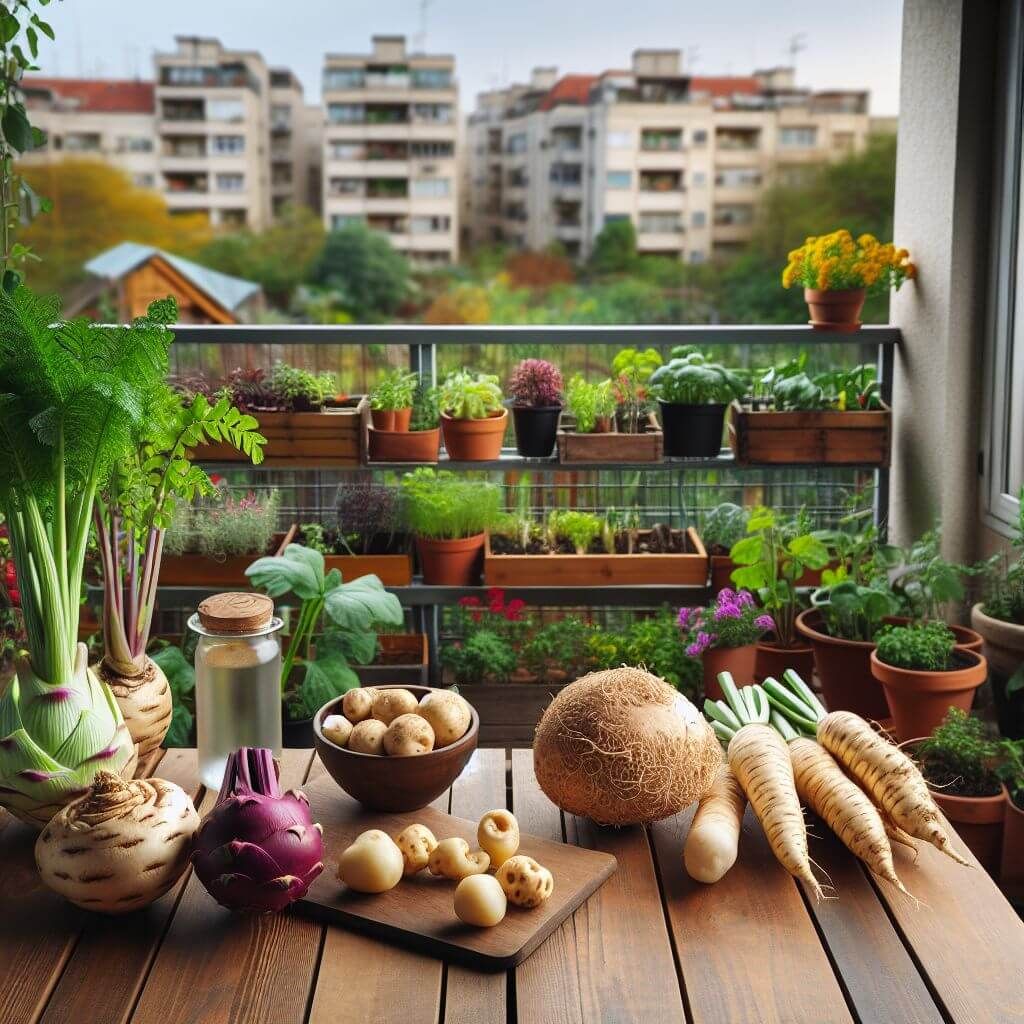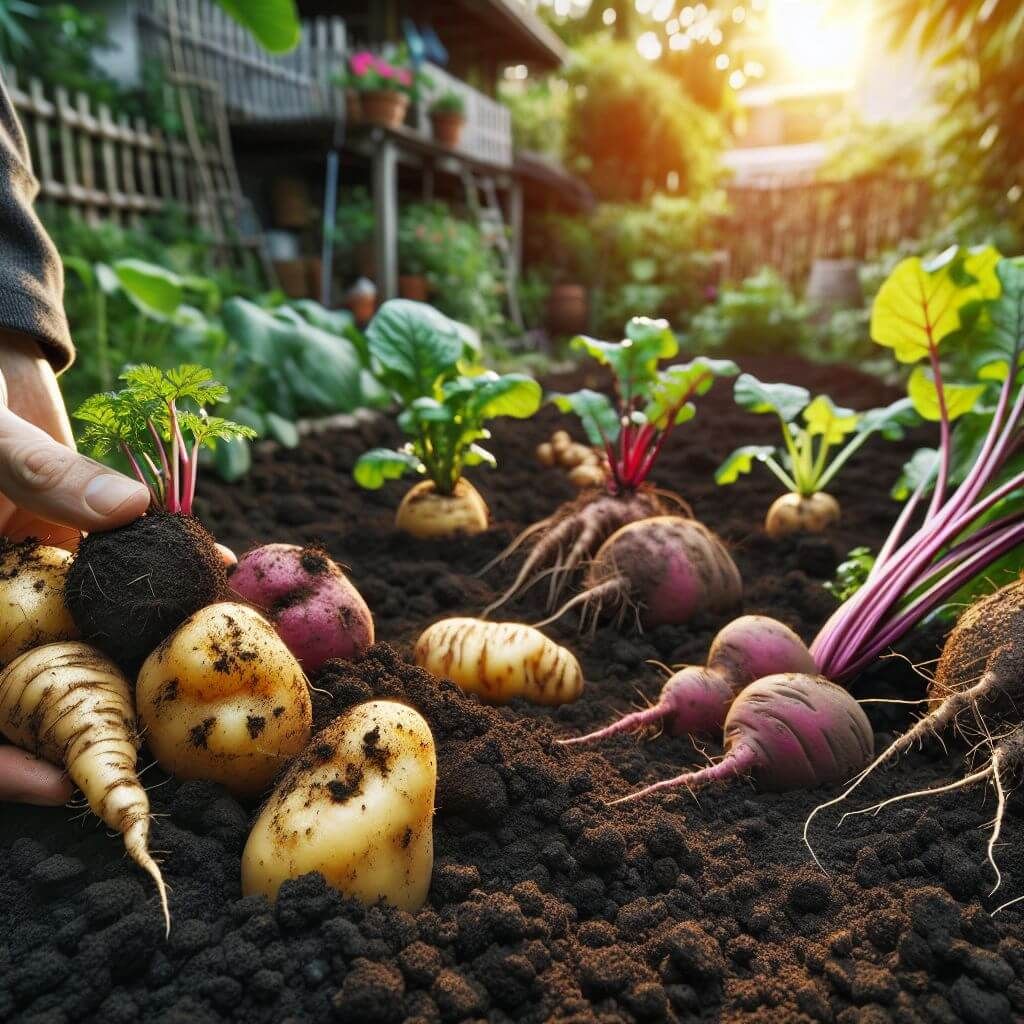
Key Takeaways
Unusual root vegetables offer unique flavors and nutritional benefits to your garden and table.
Discover how to grow and care for lesser-known tubers like celeriac, Jerusalem artichokes, jicama, oca, and skirret.
Learn simple yet effective gardening tips for cultivating these underground treasures.
Explore creative cooking methods to transform your harvest into delicious dishes.
Understand the best storage solutions to enjoy your root vegetables year-round.
Discover the Earth’s Hidden Bounty
Imagine unearthing a treasure trove of flavors right in your backyard. That’s the joy of growing unusual root vegetables. These subterranean wonders are more than just a novelty; they’re a revelation in taste and nutrition. Let’s dig into the world of these hidden gems and see how they can enrich both your garden and your meals.
Why Unusual Root Vegetables are Garden Gold
When you think of root vegetables, you might picture the common potato or carrot. But there’s a whole underground kingdom of roots waiting to be discovered. These lesser-known veggies, like the knobby celeriac or the sweet, earthy oca, bring diversity to your garden and resilience to your crops. They’re often hardier and can thrive in conditions where others might falter.
Most importantly, growing a variety of root vegetables means you’re not putting all your eggs in one basket. If one crop struggles, another might flourish, ensuring you’ve got a steady supply of fresh produce. Besides that, these tubers can be real conversation starters, with their unique shapes, colors, and flavors adding excitement to your gardening and culinary experiences.
The Nutritional Riches Beneath the Soil
Unusual root vegetables aren’t just a visual and culinary delight; they’re packed with nutrients. They often contain high levels of antioxidants, vitamins, and minerals. For example, the Jerusalem artichoke is a fantastic source of inulin, a prebiotic fiber that supports gut health.
Celeriac: A low-starch alternative to potatoes, rich in vitamin K and essential minerals.
Jerusalem Artichoke: High in iron and potassium, it’s great for blood pressure and energy levels.
Jicama: Bursting with vitamin C and fiber, it’s a hydrating snack for hot days.
Oca: Offers a good dose of vitamin C, B vitamins, and potassium.
Skirret: Known for its sweet flavor and high fiber content.
These vegetables aren’t just good for you; they’re a wise choice for your garden’s health, too. Their unique growing requirements can help improve soil structure and biodiversity, making your garden a more robust ecosystem.
Sprouting Curiosity: Unique Root Veggies You Must Try

Ready to expand your gardening repertoire? Here are some unusual root vegetables that are sure to intrigue and inspire you.
1. Celeriac: The Unsung Hero of Root Vegetables
Celeriac might not win any beauty contests with its gnarly appearance, but it’s a heavyweight in flavor. Its taste is a cross between celery and parsley, and it can be used in much the same way as potatoes. Think mashed celeriac, celeriac fries, or a creamy soup. It’s a cool-weather crop that prefers rich, well-drained soil and plenty of moisture. With a little patience, you’ll be rewarded with a bounty of this versatile veggie.
2. Jerusalem Artichoke: A Crunchy Delight with a Sweet Twist
Also known as sunchokes, Jerusalem artichokes are not from Jerusalem, nor are they artichokes. They’re related to the sunflower and boast a sweet, nutty flavor. They grow tall, with cheerful yellow flowers, and their tubers are delicious raw or cooked. Plant them in a sunny spot and watch as they become a staple in your kitchen for their versatility and health benefits.
3. Jicama: The Wonder Tuber with a Refreshing Crunch
Jicama is a crunchy, sweet root that’s often eaten raw in salads or with a sprinkle of chili powder and lime juice for a zesty snack. It grows best in warm climates with a long growing season. If you’re in a cooler area, start your jicama indoors and transplant it outside once the weather warms up. It’s worth the extra effort for this refreshing addition to your garden.
Gardening Tips for Uncommon Tubers

Now that you’re familiar with some unique tubers to plant in your garden, let’s get into the nitty-gritty of growing them. Each root vegetable comes with its own set of needs, but there are general tips that apply to most. Here’s how you can create the perfect environment for your tubers to thrive.
Best Soil Conditions for Thriving Tubers
Soil is to root vegetables what home is to us—a place where they grow and flourish. To ensure your tubers have the best start, aim for soil that’s loose, well-draining, and rich in organic matter. Here’s how you can achieve that:
Test your soil: A simple test can reveal the pH and nutrient levels, helping you amend it appropriately.
Add compost: Mix in well-rotted compost to improve soil structure and fertility.
Avoid soil compaction: Loosen the soil with a fork rather than a spade to prevent compaction, which can hinder root growth.
Remember, each tuber might have its own pH preference, so do a bit of research on your chosen variety. For instance, oca prefers slightly acidic soil, while jicama thrives in a more neutral pH.
Watering Techniques for Root-Focused Growth
Water is crucial for root development, but too much or too little can be detrimental. Most tubers prefer consistent moisture, especially during the growing season. Here’s the trick to watering right:
Check the soil: Before watering, check the soil moisture a few inches down. If it’s dry, it’s time to water.
Water deeply: Deep watering encourages roots to grow downwards, seeking moisture and nutrients.
Mulch: A layer of mulch helps retain soil moisture and regulate temperature.
Be attentive to the needs of your plants. Some, like celeriac, may need more water due to their larger leaf surface area, which can lead to quicker evaporation.
Harvesting Hints for Peak Flavor and Texture
The moment of harvest is a rewarding one, and timing is everything. Harvest too early, and you might miss out on flavor; too late, and the texture might be off. Here are a few pointers:
Know the signs: Most root vegetables are ready when their tops begin to brown or when you can see a portion of the root crowning at the soil surface.
Use the right tool: A garden fork can help lift the tubers without damaging them.
Be gentle: Handle your harvest with care to avoid bruises and cuts, which can lead to spoilage.
For example, skirret is best harvested after a couple of frosts, which sweetens its flavor. Jicama, on the other hand, should be harvested before the first frost to prevent damage.
From Ground to Gourmet: Cooking with Underground Marvels
After the harvest, it’s time to savor the fruits—or rather, roots—of your labor. These unique tubers can be transformed into a variety of mouthwatering dishes. Let’s explore how to cook them to perfection.
Roasting Root Vegetables to Perfection
Roasting brings out the natural sweetness of root vegetables and gives them a delectable caramelized exterior. Here’s a simple method:
Chop your tubers into uniform pieces for even cooking.
Toss them with olive oil, salt, and your favorite herbs and spices.
Spread them out on a baking sheet and roast at 400°F until tender and golden brown.
Try roasting celeriac with rosemary and garlic, or sweeten things up with maple-glazed oca.
Creating Hearty Soups with a Tuber Twist
Soups are a fantastic way to pack a variety of nutrients into one pot. Start with a base of onions and garlic, add chopped tubers, and cover with broth or water. Simmer until everything is tender, then blend for a smooth texture or leave it chunky for a more rustic feel. Spice it up with a dash of cream or coconut milk for a richer flavor. For those looking to enhance their emergency preparedness with exquisite flavor, consider exploring gourmet feasts that utilize your garden’s bounty.
Unearthed Salads: Adding Raw Depth to Your Dishes
Many root vegetables are delightful raw and add a satisfying crunch to salads. Jicama, for example, is excellent julienned and tossed with a citrus vinaigrette. Jerusalem artichokes can be thinly sliced and added to a green salad for a nutty twist.
Preserving Your Harvest: Storage Solutions for Root Vegetables
One of the great things about root vegetables is their longevity. With the right storage solutions, you can enjoy your harvest well into the winter months. Here’s how:
Drying and Dehydrating for Long-Lasting Snacks
Drying is a time-tested method of preservation that’s perfect for root vegetables. Slice them thinly, place them in a dehydrator or a low oven, and dry until they’re brittle. This method works wonderfully for creating chips from vegetables like celeriac or oca.
Cellaring is an age-old technique that taps into the natural coolness and humidity of underground spaces. To store your root vegetables this way, you’ll want a cellar or a cool basement that maintains a temperature of around 32-40°F (0-4°C). Here’s what to do:
Start with clean, dry vegetables. Brush off any soil, but avoid washing them to prevent mold.
Place them in wooden crates or mesh bags for good air circulation.
Keep different types of vegetables separate to prevent flavors from mingling.
Check on your vegetables periodically and remove any that show signs of spoilage.
This method works exceptionally well for vegetables like celeriac and skirret, which can last for months under the right conditions.
Canning Roots for Year-Round Delights
Canning is another fantastic way to preserve the goodness of your garden. It involves packing the vegetables into jars and sealing them in a water bath or pressure canner to prevent spoilage. Root vegetables are perfect for canning because they’re low in acidity and hold up well to the cooking process. Just remember to follow safe canning practices to avoid the risk of foodborne illnesses.
Frequently Asked Questions
Got questions? You’re not alone! Here are some common queries about unusual root vegetables and their answers:
What makes a vegetable a ‘tuber’?
A tuber is a thickened part of the stem or root that stores nutrients. It’s designed to help the plant survive through winter or dry periods and to regrow the next season. Tubers usually have “eyes” or buds from which new plants can sprout. Potatoes are the most well-known example, but there are many other types of tubers out there waiting to be explored.
Are unusual root vegetables difficult to grow?
Not necessarily! Many unusual root vegetables are quite hardy and can be easier to grow than more common vegetables. They often require less maintenance and are more resistant to diseases and pests. The key is to understand the specific needs of each type and provide the right conditions for them to flourish.
How do you incorporate tubers into a balanced diet?
Root vegetables are a healthy addition to any diet. They’re typically rich in carbohydrates, fiber, and essential nutrients. You can roast them for a hearty side dish, mash them for a comforting meal, or slice them raw into salads for a crunchy texture. They’re also great in soups, stews, and gratins. Just remember to eat a variety of vegetables to get a wide range of nutrients.
Can you save seeds from these tubers for next season?
Some tubers, like potatoes, can be propagated from the tubers themselves. Cut a piece of the tuber ensuring there are at least one or two eyes and plant it to grow a new plant. Other tubers, like Jerusalem artichokes, can be divided and replanted. However, for true seeds, it’s best to purchase from a reputable source to ensure the quality and viability of the seeds.
What are some pest control measures for these root crops?
Fortunately, many unusual root vegetables are less prone to pests than more common varieties. However, good practices include rotating your crops each year, keeping your garden clean of debris, and using row covers to protect young plants. If you do encounter pests, identify them first before choosing the appropriate organic or chemical control method.
As you embark on your gardening journey with these unusual root vegetables, remember that gardening is a process of learning and discovery. Whether you’re a seasoned gardener or a curious newbie, these tubular treasures are sure to add excitement and variety to your garden and your plate. So why not take the plunge and explore the delicious and nutritious world of root vegetables?
And when you’re ready to expand your seed collection with the finest heirloom varieties, don’t forget to check out Survival Essentials for a wide selection of seeds that will help secure your family’s food supply, no matter what the future holds. With their commitment to quality and a happiness guarantee, you can trust that your garden—and your table—will be abundant for seasons to come.







Leave a Reply